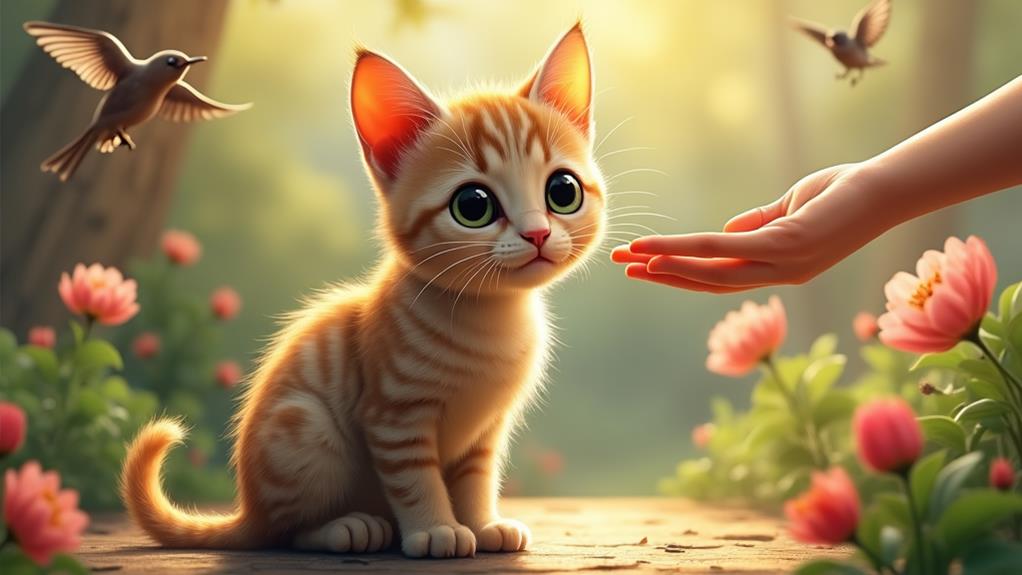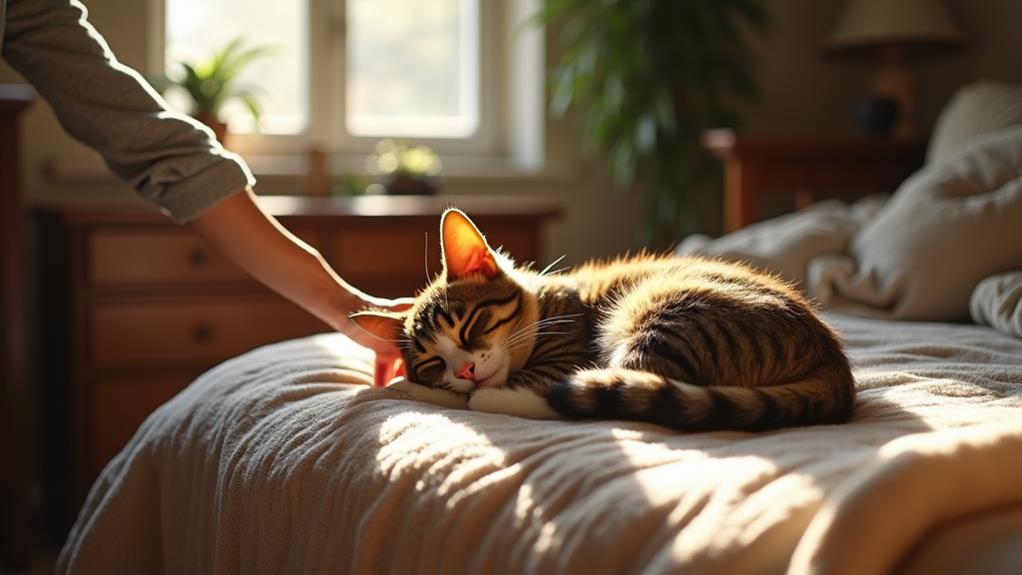When Is It Too Late to Tame a Feral Cat?

It's not impossible to tame a feral cat, but it gets tougher as they grow older. Ideally, you should start socializing them between 4-5 weeks old for the best results. After 8 weeks, feral kittens become less receptive, and older feral cats, particularly those over a year, present ingrained fear and require more patience. Look for signs like approachability and acceptance of treats; they're indicators that taming might work. If you face challenges, remember there are alternatives like TNR programs or barn cat placements. Understanding these aspects can greatly aid your efforts in fostering a trusting relationship with feral cats.
Understanding Feral Cat Behavior
Understanding feral cat behavior is vital if you're thinking about helping these elusive creatures. Feral cats haven't had contact with humans, making them wary and often scared of strangers. Their behavior is driven by survival instincts, meaning they tend to hide or run when approached. Unlike stray cats, who've interacted with humans before, feral cats rely on instincts and often form colonies, where they communicate and depend on each other for resources. This social structure influences their behavior greatly.
When considering kitten socialization, maturity plays a key role. Young kittens, especially those under months old, are more receptive to socialization efforts. They're more likely to become comfortable with humans and adapt to domestic life. On the other hand, older feral cats present a greater challenge. Their fear responses are ingrained, making it difficult to tame feral cats past a certain maturity. Positive reinforcement can help, but patience is key.
If you aim to tame a feral cat, it's significant to understand the nuances of cat behavior. Knowing how they react to contact with humans and utilizing strategies like positive reinforcement can make a difference in their adaptability.
Ideal Age for Taming
Knowing when to start taming feral kittens can make all the difference in their ability to adjust to human companionship. The perfect stage for taming kittens is between 4 to 5 weeks. At this point, they're incredibly receptive to socialization and can quickly adapt to interactions with humans. This is the best time to introduce them to a loving environment where they can learn to trust and feel comfortable around people.
If you wait until they are older, say around 8 weeks, the window for easy socialization begins to close. While taming is still possible, the chances of success start to diminish considerably after this point. Kittens older than 6 weeks might require more time and patience because they can exhibit increased fear and resistance to human interaction.
That said, the temperament of each feral kitten can vary. Some might remain aloof despite your best efforts, while others may be open to socialization even beyond the perfect stage window. Although some sources claim taming is possible up to 3 years old, older feral cats often have deeply ingrained fear responses, making socialization more challenging and demanding more patience from you.
Signs a Cat Can Be Tamed

Identifying signs that a cat can be tamed is vital for anyone attempting to socialize a feral feline. When you observe a feral cat showing curiosity about its environment, that's a promising sign. Cats that investigate rather than hide are generally more open to socialization. Approachability in feral cats reveals potential for taming; if a cat sits nearby during feeding times, it's showing interest. This behavior indicates the cat's becoming more comfortable around you and the environment you provide.
Feeding behavior is another key indicator. Kittens that eat while you're present, or even approach for food, demonstrate a higher likelihood of successful socialization. This behavior shows they're beginning to associate humans with positive experiences. Gradual trust development is vital. When a cat starts accepting treats directly from your hand, it's a clear sign of progress in building trust and interaction.
Consistency in observing a cat's behavior over time is significant. If you notice a feral cat becoming more comfortable with human presence, it's a strong indicator that taming is possible. Always look for these signs to gauge their readiness for socialization and to foster trust effectively.
Challenges With Older Cats
For those working to tame older feral cats, the path can be particularly challenging. These cats, typically over one year of maturity, often have deeply ingrained fear responses that complicate the socialization process. Unlike kittens, older feral cats need months or even years to adjust to human interaction and their new environment. They might exhibit stress-related behaviors such as yowling, hiding, or aggression, which can slow down the taming process and test your patience.
Environmental changes, like moving indoors, can be traumatic for them. They might resist human contact, finding the shift difficult. This resistance can make it harder to encourage them to interact with people. Older feral cats often prefer to bond with just one person initially, which can complicate the adoption process. This means they might need more time to adjust to further human interactions.
As you work with these cats, understand that the taming process requires a lot of patience and compassion. The expedition to socialization might be long, but with time and persistence, older feral cats can learn to adapt and eventually become open to new experiences and environments.
Benefits of Socialization

Despite the challenges with older feral cats, there's a silver lining in the benefits of socialization. When you introduce a feral cat to human interaction during their essential developmental periods, especially before 8 weeks of maturity, they're more likely to develop friendly behavior. This early exposure means they're better equipped to trust humans, enhancing their confidence in adapting to a home environment. Such socialization is fundamental in preventing future behavioral problems, making for a harmonious relationship with their human families.
Socialization isn't just about making a feral cat friendly—it greatly increases their chances of adoption. Cats that grow comfortable with multiple humans through fostering programs tend to be more adaptable and sociable. This adaptability is key in ensuring their successful integration into households, reducing the risk of abandonment or return to shelters. When you help a feral kitten build trust and confidence, you're not only improving their quality of life but also aiding in the management of feral cat populations. Ultimately, fostering and socialization programs are essential. They highlight how important these efforts are in linking feral cats to loving homes, offering them the chance for a better future.
Alternatives to Taming
Exploring alternatives to taming can be crucial when dealing with feral cats that may not adapt well to human interaction. Instead of focusing on taming feral kittens or adult cats, you might consider methods that allow them to thrive in their natural environments. One effective strategy is the trap-neuter-return (TNR) program, which helps control feral cat populations without forcing them into uncomfortable domestic situations. TNR addresses overpopulation by neutering and then returning the cats to their community, where they can continue to live in familiar surroundings.
Providing food and water in designated areas can support these community cats, ensuring they have access to basic needs. Furthermore, collaborating with a local shelter can lead to programs that offer semi feral or feral cats a safe haven, focusing on cat care rather than taming.
Some feral cats may find a suitable role as barn cats, where they can contribute to pest control while maintaining their independence. Foster care programs can also serve as temporary solutions, offering a controlled environment for evaluating if a feral cat can adapt to human interaction. Consider these alternatives:
- Trap-neuter-return (TNR)
- Providing food and water
- Barn cat programs
- Foster care options
- Local shelter partnerships
Community Support and Resources

When managing feral cat populations, community support and resources play a vital role in guaranteeing success. Local shelters often provide valuable resources and education on proper care and socialization techniques. They offer guidance on TNR (trap-neuter-return) programs, which organizations like Alley Cat Allies champion. TNR is a proven method for controlling feral cat populations and improving cat welfare. By neutering and returning cats to their colonies, you effectively reduce the number of new litters.
Networking within your community is fundamental. Sharing experiences and resources can aid considerably in the successful taming and rehoming of these cats. You can tap into access to literature, expert blogs, and online forums to expand your knowledge on feral cat behavior and effective taming strategies.
Collaborating with animal behaviorists can lead to enhanced outcomes in socializing feral cats. They can provide insights into best practices that foster caregivers can implement. This collaboration guarantees that you're equipped with the necessary skills to address challenges in taming feral cats.




